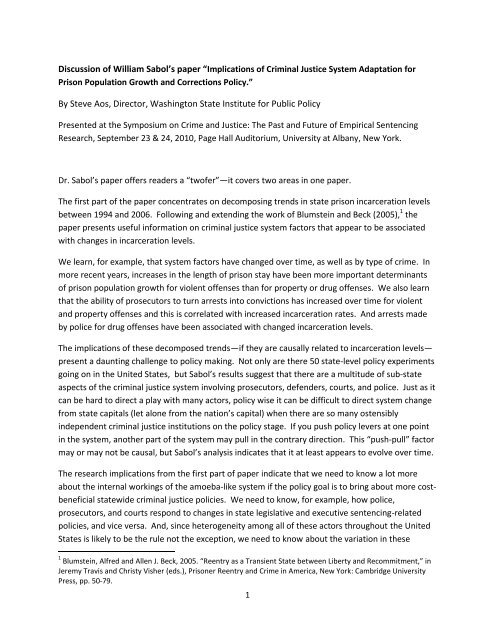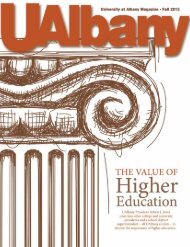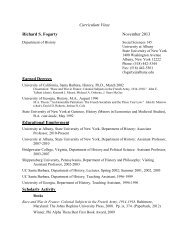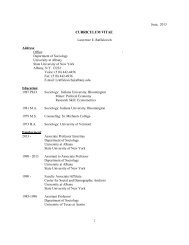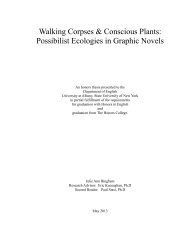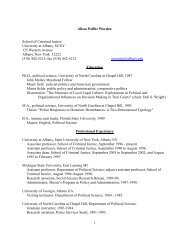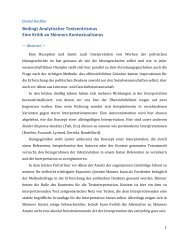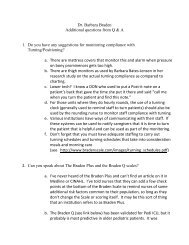Steve Aos - University at Albany
Steve Aos - University at Albany
Steve Aos - University at Albany
You also want an ePaper? Increase the reach of your titles
YUMPU automatically turns print PDFs into web optimized ePapers that Google loves.
Discussion of William Sabol’s paper “Implic<strong>at</strong>ions of Criminal Justice System Adapt<strong>at</strong>ion for<br />
Prison Popul<strong>at</strong>ion Growth and Corrections Policy.”<br />
By <strong>Steve</strong> <strong>Aos</strong>, Director, Washington St<strong>at</strong>e Institute for Public Policy<br />
Presented <strong>at</strong> the Symposium on Crime and Justice: The Past and Future of Empirical Sentencing<br />
Research, September 23 & 24, 2010, Page Hall Auditorium, <strong>University</strong> <strong>at</strong> <strong>Albany</strong>, New York.<br />
Dr. Sabol’s paper offers readers a “twofer”—it covers two areas in one paper.<br />
The first part of the paper concentr<strong>at</strong>es on decomposing trends in st<strong>at</strong>e prison incarcer<strong>at</strong>ion levels<br />
between 1994 and 2006. Following and extending the work of Blumstein and Beck (2005), 1 the<br />
paper presents useful inform<strong>at</strong>ion on criminal justice system factors th<strong>at</strong> appear to be associ<strong>at</strong>ed<br />
with changes in incarcer<strong>at</strong>ion levels.<br />
We learn, for example, th<strong>at</strong> system factors have changed over time, as well as by type of crime. In<br />
more recent years, increases in the length of prison stay have been more important determinants<br />
of prison popul<strong>at</strong>ion growth for violent offenses than for property or drug offenses. We also learn<br />
th<strong>at</strong> the ability of prosecutors to turn arrests into convictions has increased over time for violent<br />
and property offenses and this is correl<strong>at</strong>ed with increased incarcer<strong>at</strong>ion r<strong>at</strong>es. And arrests made<br />
by police for drug offenses have been associ<strong>at</strong>ed with changed incarcer<strong>at</strong>ion levels.<br />
The implic<strong>at</strong>ions of these decomposed trends—if they are causally rel<strong>at</strong>ed to incarcer<strong>at</strong>ion levels—<br />
present a daunting challenge to policy making. Not only are there 50 st<strong>at</strong>e-level policy experiments<br />
going on in the United St<strong>at</strong>es, but Sabol’s results suggest th<strong>at</strong> there are a multitude of sub-st<strong>at</strong>e<br />
aspects of the criminal justice system involving prosecutors, defenders, courts, and police. Just as it<br />
can be hard to direct a play with many actors, policy wise it can be difficult to direct system change<br />
from st<strong>at</strong>e capitals (let alone from the n<strong>at</strong>ion’s capital) when there are so many ostensibly<br />
independent criminal justice institutions on the policy stage. If you push policy levers <strong>at</strong> one point<br />
in the system, another part of the system may pull in the contrary direction. This “push-pull” factor<br />
may or may not be causal, but Sabol’s analysis indic<strong>at</strong>es th<strong>at</strong> it <strong>at</strong> least appears to evolve over time.<br />
The research implic<strong>at</strong>ions from the first part of paper indic<strong>at</strong>e th<strong>at</strong> we need to know a lot more<br />
about the internal workings of the amoeba-like system if the policy goal is to bring about more costbeneficial<br />
st<strong>at</strong>ewide criminal justice policies. We need to know, for example, how police,<br />
prosecutors, and courts respond to changes in st<strong>at</strong>e legisl<strong>at</strong>ive and executive sentencing-rel<strong>at</strong>ed<br />
policies, and vice versa. And, since heterogeneity among all of these actors throughout the United<br />
St<strong>at</strong>es is likely to be the rule not the exception, we need to know about the vari<strong>at</strong>ion in these<br />
1 Blumstein, Alfred and Allen J. Beck, 2005. “Reentry as a Transient St<strong>at</strong>e between Liberty and Recommitment,” in<br />
Jeremy Travis and Christy Visher (eds.), Prisoner Reentry and Crime in America, New York: Cambridge <strong>University</strong><br />
Press, pp. 50‐79.<br />
1
el<strong>at</strong>ionships <strong>at</strong> the sub-n<strong>at</strong>ional detail. Th<strong>at</strong> is, county prosecutors in Washington St<strong>at</strong>e are likely<br />
to respond to policy changes from Olympia in different ways than prosecutors in Los Angeles<br />
respond to policy changes in Sacramento.<br />
In the second part of his paper, Sabol begins by noting th<strong>at</strong> the first part of the paper “is severely<br />
limited.” He notes th<strong>at</strong> this limit<strong>at</strong>ion surfaces because the decomposition analysis presented in<br />
the first part “cannot address causal issues rel<strong>at</strong>ed to prison popul<strong>at</strong>ion growth even if it can point<br />
out areas for consider<strong>at</strong>ion and research.” Bummer.<br />
The paper proceeds by providing a brief and selected narr<strong>at</strong>ive review of some studies th<strong>at</strong> have, in<br />
turn, summarized the research liter<strong>at</strong>ure on the causal rel<strong>at</strong>ionships between crime and criminal<br />
justice policies. From a policy perspective, the news here is not pretty. These reviews indic<strong>at</strong>e th<strong>at</strong>,<br />
in general, researchers have been unable to contribute precise and convincing estim<strong>at</strong>es of<br />
particular policy options for several reasons. First, researchers in this area have been forced to use<br />
fairly aggreg<strong>at</strong>ed d<strong>at</strong>a because they usually lack individual-level inform<strong>at</strong>ion <strong>at</strong> the point where<br />
actual decisions are made by criminals and criminal justice practitioners. With so much inform<strong>at</strong>ion<br />
unobserved (to researchers), and with random assignment the exception not the rule, it has been<br />
difficult to model rel<strong>at</strong>ionships credibly.<br />
The most significant reason for a weak research base, however, is th<strong>at</strong> criminal justice policies give<br />
every known indic<strong>at</strong>ion of being endogenous. Crime and criminal justice policies appear to be<br />
determined jointly and this has confounded the ability of researchers to identify causal<br />
rel<strong>at</strong>ionships th<strong>at</strong> would otherwise be so useful for setting policies. Sabol notes th<strong>at</strong> the usual<br />
st<strong>at</strong>istical procedures to overcome endogeniety—unassailable instrumental variables—are very<br />
hard to come by in a world where so many things are interrel<strong>at</strong>ed. In concluding the second part of<br />
the paper, Sabol encourages the research community to continue to look for better instruments,<br />
and th<strong>at</strong> it should also look for try to exploit n<strong>at</strong>ural experiments and employ m<strong>at</strong>ching estim<strong>at</strong>ors.<br />
On this last point, it is worth emphasizing th<strong>at</strong>, if more widely used, regression discontinuity<br />
approaches may be able to help identify some causal effects for certain sentencing-rel<strong>at</strong>ed policies.<br />
When st<strong>at</strong>es, such as Washington St<strong>at</strong>e, implement presumptive st<strong>at</strong>ewide sentencing grids, they<br />
are forced to adopt somewh<strong>at</strong> arbitrary cut-points on the particular sanctions received by convicted<br />
offenders. Regression discontinuity designs offer the potential to <strong>at</strong> least identify “local tre<strong>at</strong>ment”<br />
effects around some of these sentencing rules. And, since sentencing grids have many of these<br />
cutoff levels embedded in them, the estim<strong>at</strong>ion of many local tre<strong>at</strong>ment effects offer the potential<br />
to inform a more generalized set of estim<strong>at</strong>es about sentencing. This is a worthy area of future<br />
research, particularly because st<strong>at</strong>es with sentencing grids may often have comprehensive<br />
administr<strong>at</strong>ive d<strong>at</strong>abases with sentencing and conviction d<strong>at</strong>a (because the sanctions for an<br />
offender’s subsequent offenses will typically be a function the current offense and criminal history).<br />
Thus an important part of a n<strong>at</strong>ional research agenda could focus on regression discontinuity<br />
designs in those st<strong>at</strong>es with grid systems and good electronic administr<strong>at</strong>ive d<strong>at</strong>a.<br />
2
Research Needs: More Fully Developing the Current Model<br />
Springing off the concepts addressed in Sabol’s paper, the remainder of my comments centers on<br />
wh<strong>at</strong> I think are the most pressing needs for research. I offer these suggestions from my position as<br />
a policy advisor to the Washington St<strong>at</strong>e legisl<strong>at</strong>ure. While there is a host of interesting research<br />
questions raised by the paper, I only focus on those th<strong>at</strong> I think are most clearly tied to the practical<br />
decisions th<strong>at</strong> face legisl<strong>at</strong>ive bodies.<br />
Legisl<strong>at</strong>ures need, I believe, two things from researchers to help them form more effective criminal<br />
justice public policies: consistently estim<strong>at</strong>ed “crime impact st<strong>at</strong>ements” and “fiscal impact<br />
st<strong>at</strong>ements” for a portfolio of policy choices. This inform<strong>at</strong>ion would allow the comput<strong>at</strong>ion of<br />
costs and benefits, return on investment, and the riskiness of portfolios of policy choices.<br />
I start with the assumption th<strong>at</strong> legisl<strong>at</strong>ures want to accomplish three principal goals for each<br />
criminal justice policy they consider: improve justice, reduce crime (victim costs), and control<br />
taxpayer costs. The agenda I discuss here is only rel<strong>at</strong>ed to the last two of the troika: crime and<br />
taxpayer spending. I do not address a research agenda for the justice sentencing goal.<br />
To wh<strong>at</strong> degree, then, can the current st<strong>at</strong>e of research help st<strong>at</strong>es cre<strong>at</strong>e a crime impact st<strong>at</strong>ement<br />
and a fiscal impact st<strong>at</strong>ement so th<strong>at</strong> current policies can be analyzed? As it turns out, there is a<br />
fairly large research liter<strong>at</strong>ure on the effect of incarcer<strong>at</strong>ion r<strong>at</strong>es on crime. 2 Unfortun<strong>at</strong>ely, this<br />
research lacks the detail necessary to inform very many specific decisions th<strong>at</strong> typically arise in st<strong>at</strong>e<br />
capitals. If we highlight the limit<strong>at</strong>ions in this research, it can point to areas in need of<br />
improvement.<br />
Many of the existing studies addressing the prison-crime rel<strong>at</strong>ionship in the United St<strong>at</strong>es construct<br />
models using st<strong>at</strong>e-level d<strong>at</strong>a over a number of years to estim<strong>at</strong>e the parameters of an equ<strong>at</strong>ion of<br />
this general form:<br />
In this typical model, crime C in st<strong>at</strong>e s and year y is estim<strong>at</strong>ed to be a function of a st<strong>at</strong>e’s overall<br />
average daily prison popul<strong>at</strong>ion, ADP, a vector of control variables, X, and an error term, e. Crime is<br />
most frequently measured with d<strong>at</strong>a from the FBI’s Uniform Crime Reporting (UCR) system. The<br />
variables are usually divided by popul<strong>at</strong>ion so th<strong>at</strong> they are expressed as r<strong>at</strong>es. The models are<br />
almost always estim<strong>at</strong>ed with a log-log functional form, <strong>at</strong> least for the dependent and the main<br />
“independent” policy variables. Several authors have also observed th<strong>at</strong> the st<strong>at</strong>e-level time series<br />
d<strong>at</strong>a often used to estim<strong>at</strong>e equ<strong>at</strong>ion (1) are likely have unit roots. 3 Thus, to help avoid estim<strong>at</strong>ing<br />
spurious rel<strong>at</strong>ionships, some authors estim<strong>at</strong>e equ<strong>at</strong>ion (1) in first differences since the time series<br />
2 A recent survey of this liter<strong>at</strong>ure and analysis of the empirical estim<strong>at</strong>es from 35 studies is provided in T. B.<br />
Marvell (2009). Prison Popul<strong>at</strong>ion and Crime. Marvell’s paper will be published in the Handbook on the Economics<br />
of Crime, Edited by Bruce L. Benson and Paul R. Zimmerman, Edward Elgar Publishing, September 2010.<br />
3 See, for example, Marvell, 2009. See also, W. Spelman (2008). Specifying the rel<strong>at</strong>ionship between crime and<br />
prisons, Journal of Quantit<strong>at</strong>ive Criminology, 24, 149-178.<br />
3
typically do not exhibit unit roots after differencing once. As noted above, there is also<br />
considerable concern in the research liter<strong>at</strong>ure on the econometric implic<strong>at</strong>ion of the possible<br />
simultaneous rel<strong>at</strong>ionship between the variables of interest in equ<strong>at</strong>ion (1): th<strong>at</strong> is, crime may be a<br />
function of ADP, but ADP may also be a function of crime. This simultaneous rel<strong>at</strong>ionship can cause<br />
st<strong>at</strong>istically biased estim<strong>at</strong>es if not dealt with.<br />
In order to produce a “crime impact st<strong>at</strong>ement,” marginal effects from this generic log-log crime<br />
model are then obtained with:<br />
In equ<strong>at</strong>ion (2), the change in crime is estim<strong>at</strong>ed with E, the crime-prison elasticity obtained from<br />
coefficient b of the typical loglog estim<strong>at</strong>ion of equ<strong>at</strong>ion (1); UCR, the reported crime r<strong>at</strong>e; ADP, the<br />
incarcer<strong>at</strong>ion r<strong>at</strong>e, and RR<strong>at</strong>e, the reporting r<strong>at</strong>e to police by crime victims. The marginal effects<br />
are sometimes calcul<strong>at</strong>ed either <strong>at</strong> the mean values for ADP-UCR-RR<strong>at</strong>es or, more to the point for<br />
policy purposes, <strong>at</strong> the most recent values for ADPUCR-RR<strong>at</strong>es. The log-log estim<strong>at</strong>ion of the<br />
constant elasticity E implies diminishing returns when E is less than one and incarcer<strong>at</strong>ion r<strong>at</strong>es are<br />
raised. Similarly, an elasticity less than one coupled with reduced ADP implies increasing returns.<br />
To understand the needs for improved research, it is instructive to examine current limit<strong>at</strong>ions in<br />
both the d<strong>at</strong>a and methodological assumptions in equ<strong>at</strong>ion (1).<br />
We can begin with the dependent variable, crime. In the studies estim<strong>at</strong>ing these types of<br />
equ<strong>at</strong>ions, crime is most often measured with d<strong>at</strong>a from the FBI’s UCR. These d<strong>at</strong>a count the<br />
number of crimes reported to police. Some studies estim<strong>at</strong>e a model of total UCR crime reported<br />
to police, while other studies estim<strong>at</strong>e two equ<strong>at</strong>ions, one for violent crime reported to police, and<br />
another for property crime reported to police. Still other studies break the analysis down further<br />
and estim<strong>at</strong>e equ<strong>at</strong>ions for the seven major types of “Part 1” crimes in the UCR d<strong>at</strong>a: murder, rape,<br />
robbery, aggrav<strong>at</strong>ed assault, burglary, theft, and motor vehicle theft.<br />
One significant problem with the “Part 1” UCR crime d<strong>at</strong>a is th<strong>at</strong> they do not m<strong>at</strong>ch directly how<br />
some st<strong>at</strong>es, including Washington, define felony crimes. In Washington, this applies to two types<br />
of crimes in particular: felony sex crimes and theft/larceny. The UCR sex offense d<strong>at</strong>a only count<br />
rapes of females over the age of 12. In addition to this obvious limit<strong>at</strong>ion in the UCR d<strong>at</strong>a, there are<br />
other felony sex crimes (e.g., child molest<strong>at</strong>ion), defined by the Revised Code of Washington th<strong>at</strong><br />
are not included in the UCR rape c<strong>at</strong>egory. Similarly, the UCR d<strong>at</strong>a count some types of theft crimes<br />
th<strong>at</strong> are below the threshold of felony theft in Washington. Therefore, adjustments to the UCR<br />
d<strong>at</strong>a are needed to better m<strong>at</strong>ch the d<strong>at</strong>a needs for actual policy making in the st<strong>at</strong>es. A<br />
comprehensive st<strong>at</strong>e-by-st<strong>at</strong>e review of criminal codes and ways to adjust the UCR d<strong>at</strong>a needs to be<br />
undertaken.<br />
We can then examine the main policy variable, average daily prison popul<strong>at</strong>ion. In virtually all<br />
studies in the current research liter<strong>at</strong>ure, the policy variable examined is st<strong>at</strong>ewide prison average<br />
4
daily popul<strong>at</strong>ion. In most studies, this is measured by counting the total number of inm<strong>at</strong>es <strong>at</strong> the<br />
beginning of a year, or the end of a year, and dividing by a st<strong>at</strong>e’s popul<strong>at</strong>ion aggreg<strong>at</strong>e to obtain an<br />
overall incarcer<strong>at</strong>ion r<strong>at</strong>e.<br />
Measuring ADP with the total number of offenders—as opposed to more refined c<strong>at</strong>egories of<br />
offenders convicted of violent, property, or drug offenses, or defining offenders based on an<br />
actuarial risk assessment as high-risk, moder<strong>at</strong>e-risk, or lower-risk offenders—has been necessary in<br />
cross-st<strong>at</strong>e analyses, because total ADP is usually the only inform<strong>at</strong>ion available. This restriction,<br />
however, means th<strong>at</strong> the typical research study only measures the average effect on crime of the<br />
average offender sentenced to prison. The criminal propensities of different types of offenders, on<br />
the other hand, are quite heterogeneous in terms of the amount and types of crime committed. It<br />
is widely known, for example, th<strong>at</strong> sex offenders have different crime characteristics than property<br />
offenders. We know th<strong>at</strong> there is wide heterogeneity in offenders with respect to the probability of<br />
re-offense. 4 Yet, equ<strong>at</strong>ion (1) tre<strong>at</strong>s all ADP as if it is a homogeneous unit of measurement. This<br />
severely limits the ability of current research findings to offer practical policy advice when crafting<br />
specific sentencing policies.<br />
Given trends in sentencing policies in the United St<strong>at</strong>es, this “average offender” limit<strong>at</strong>ion poses <strong>at</strong><br />
least three empirical problems. First, the average mix of offenders in prison has changed over time.<br />
For example, in Washington St<strong>at</strong>e, there were virtually no offenders in prison for drug crimes prior<br />
to the mid-1980s. Sentencing laws were changed in the l<strong>at</strong>e 1980s and the average proportion of<br />
drug offenders in ADP increased substantially. The average risk for reoffense has also exhibited long<br />
term trends. Among offenders released from prison in Washington, there has been a 23 percent<br />
increase in offenders’ risk level between 1991 and 2005. 5 Thus, the average crime/ADP coefficient<br />
from most regressions may not be aligned with the current mix of offenders in a st<strong>at</strong>e’s ADP.<br />
The second reason why parameters in models like equ<strong>at</strong>ion (1) are limited in their ability to inform<br />
actual policy choices facing legisl<strong>at</strong>ures is th<strong>at</strong> policy decisions to raise or lower ADP are not usually<br />
across-the-board or “average” decisions. A legisl<strong>at</strong>ure will rarely raise sentences for all types of<br />
crimes by a uniform amount, nor will a legisl<strong>at</strong>ure typically lower sentences uniformly for all types<br />
of crimes (although this has been done). If a legisl<strong>at</strong>ure were to uniformly lower lengths of stay, for<br />
example, a high risk sex offender would be tre<strong>at</strong>ed the same as a low risk drug offender. Since this<br />
is likely to be seen as an undesirable policy, if prison ADP is to be adjusted, legisl<strong>at</strong>ive discussions<br />
are more likely to focus on <strong>at</strong> least some level of policy selectivity in which types of offenders are<br />
released early. Much more often, a legisl<strong>at</strong>ure will adjust sentencing st<strong>at</strong>utes for particular types of<br />
crimes, r<strong>at</strong>her than adopt across-the board changes.<br />
The third significant reason why the average elasticity estim<strong>at</strong>es from current research in not too<br />
useful for policy making is th<strong>at</strong> not all policies th<strong>at</strong> affect prison ADP have an equal effect on crime.<br />
4 E. Drake, S. <strong>Aos</strong>, & R. Barnoski (2010). Washington's Offender Accountability Act: Final Report on Recidivism<br />
Outcomes. Olympia: Washington St<strong>at</strong>e Institute for Public Policy, Document No.10-01-1201.<br />
5 Ibid.<br />
5
Durlauf and Nagin (2010) provide a very useful review and analysis of the research liter<strong>at</strong>ure on the<br />
two sentencing factors th<strong>at</strong> determine a st<strong>at</strong>e’s ADP: the probability of a sentence to prison given a<br />
conviction, and the severity of the sentence in terms of length of prison stay.<br />
Each of these sentencing parameters—the certainty of punishment and the severity of<br />
punishment—are affected by different sentencing policies. Yet, as Durlauf and Nagin found, the<br />
research liter<strong>at</strong>ure indic<strong>at</strong>es th<strong>at</strong> the two types of policies are likely to have quite different effects<br />
on crime. They conclude:<br />
The key empirical conclusion of our liter<strong>at</strong>ure review is th<strong>at</strong> there is rel<strong>at</strong>ively little reliable<br />
evidence of vari<strong>at</strong>ion in the severity of punishment having a substantial deterrent effect but<br />
th<strong>at</strong> there is rel<strong>at</strong>ively strong evidence th<strong>at</strong> vari<strong>at</strong>ion in the certainty of punishment has a<br />
large deterrent effect. 6<br />
Using the Durlauf and Nagin results, one would conclude th<strong>at</strong> the mean ADP elasticity from<br />
equ<strong>at</strong>ion (1) for a sentencing policy th<strong>at</strong> affects the certainty of punishment would be higher.<br />
Conversely, the mean ADP elasticity for a sentencing policy th<strong>at</strong> affects the length of prison stay<br />
would be lower. While the st<strong>at</strong>e of research may not allow a clear deline<strong>at</strong>ion of the magnitude of<br />
these differential effects, the direction seems clear based on the findings of Durlauf and Nagin.<br />
This means th<strong>at</strong> the coefficients obtained from equ<strong>at</strong>ions such as (1) above can be thought of as<br />
only rough guides for the effectiveness of average sentencing changes. Until new research can<br />
address the issues raised, the coefficients obtained from these equ<strong>at</strong>ions need to be adjusted to<br />
better estim<strong>at</strong>e the specific policy choices available to legisl<strong>at</strong>ures. Adjustments need to reflect: (a)<br />
the wide heterogeneity of criminal propensities among offenders, (b) th<strong>at</strong> legisl<strong>at</strong>ures usually adjust<br />
sentencing policies differentially for different types of crimes, and (c), th<strong>at</strong> the particular type of<br />
sentencing policy adopted is likely to affect crime differentially depending on whether the policy<br />
changes the certainty or severity of punishment.<br />
Finally, it is worth re-emphasizing the main concluding point made by Sabol: the inability of most<br />
current research to control for the apparent simultaneity between crime and criminal justice<br />
policies. Crime may be affected by prison, but there is also evidence in many of the studies th<strong>at</strong> the<br />
use of prison is affected by crime. 7 This simultaneous rel<strong>at</strong>ionship, if not accounted for, will<br />
probably bias the coefficient in a model like equ<strong>at</strong>ion (1) downward. If a legisl<strong>at</strong>ure’s willingness to<br />
provide prison cells is motiv<strong>at</strong>ed by changes in crime levels, then the observed rel<strong>at</strong>ionship<br />
between prison and crime can be measuring both prison supply decisions and criminal response to<br />
prison levels. Therefore, an observed effect of prison on crime is likely to be muted because some<br />
of the observed rel<strong>at</strong>ionship reflects the use of more prison as a result of crime changes. As Sabol<br />
notes, technically these models require an exogenous source of vari<strong>at</strong>ion—an instrumental variable<br />
6 S. N. Durlauf & D. S. Nagin (2010). The Deterrent Effect of Imprisonment. N<strong>at</strong>ional Bureau of Economic Research<br />
working paper. http://www.nber.org/confer/2010/CRIs10/Durlauf_Nagin.pdf<br />
7 Marvell, 2009.<br />
6
or a discontinuity around some arbitrary sentencing cut-off level—th<strong>at</strong> affects the use of prison but<br />
is probably otherwise unrel<strong>at</strong>ed to the error term in equ<strong>at</strong>ion (1). These instrumental variables are<br />
hard to find so there are many more estim<strong>at</strong>es th<strong>at</strong> do not account for simultaneity than th<strong>at</strong> do.<br />
Future research needs to address this limit<strong>at</strong>ion. In the existing research liter<strong>at</strong>ure, there have<br />
been only a few <strong>at</strong>tempts to measure credibly the magnitude of this simultaneous rel<strong>at</strong>ionship. 8<br />
8 S. D. Levitt (1996). The Effect of Prison Popul<strong>at</strong>ion Size on Crime R<strong>at</strong>es: Evidence From Prison Overcrowding<br />
Litig<strong>at</strong>ion. The Quarterly Journal of Economics, 111, 319-51. W. Spelman (2005). Jobs or Jails? The Crime Drop in<br />
Texas. Journal of Policy Analysis and Management, 24(1), 133-165.<br />
7


